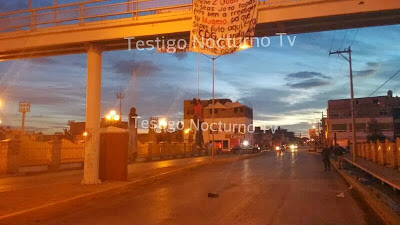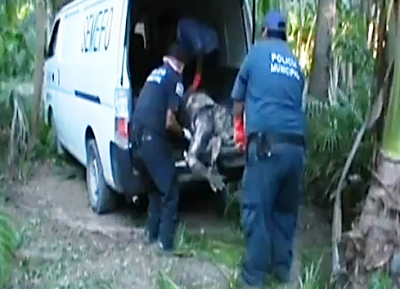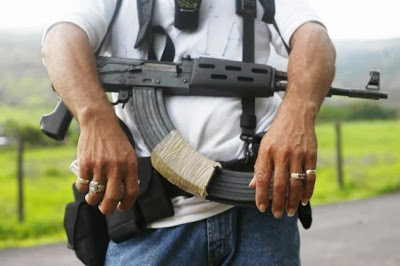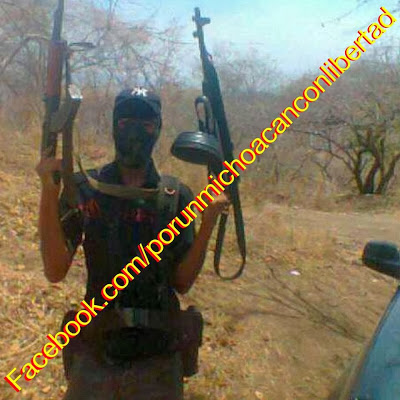Note: A couple of months ago, I viewed this Ioan Grillo's video of the narco museum (at bottom of this post) and this post from Small Wars Journal provides some interesting information, the SWJ article below is by;
David Kuhn,
Anikh Wadhawan and Robert Bunker..
Mexican Cartel Tactical Note #20: RPG-29 Anti-Armor Munitions
Note—Up until recently, weapons
that provide for armor and bunker defeat capability at the levels that the
RPG-29 is capable of, have not been seen in the hands of the Mexican
cartels. The fact that they have successfully
obtained them—and the origin and mechanism by which they were obtained should
be of extreme concern to everyone.
Key Information: See the RPG-29
images in the 2:26 minute video Drugs, Guns and; Bling: Inside the Mexican
Army's Narco War Museum hosted by the author/journalist Ioan Grillo (El Narco:
Inside Mexico’s Criminal Insurgency) and filmed by Ross McDonnell via BuzzFeed
Central (Original video posting 10 September 2013).
Who: The Mexican cartels; the
specific cartel which had the RPG-29VR round in its possession is not
identified.
What: The RPG-29VR is an advanced
Russian anti-armor round capable of defeating all types of modern main-battle
tanks including the American M1A1/2 Abrams. See Photo 1 where it is being held
by Ioan Grillo.
When: The date the RPG-29VR was
placed in the museum’s collection is unknown.
Where: The Mexican Army museum
where the RPG-29VR round resides is found in Mexico City and is not open to the
public. It is meant to provide training
for the Mexican Army concerning narco culture (narco cultura).
Why: The Mexican cartels have
been increasingly obtaining military grade weaponry in their conflicts with
each other and with Mexican federal police and military and naval units.
Note: The RPG-29 launcher and
PG-29VR round combination is in service in a number of countries. There are
indications that Mexico may also be fielding the weapon on a limited
basis.
This weaponry has been used by Hezbollah
forces against Israeli armor in Lebanon in 2006. The reader will also note that
the round in the frame extracted from the video has a blue band midway along
its length. This marking is common and
should not be confused with content color-code markings on standard
munitions.
Light blue color-codes are often
used by the U.S. and several other countries to identify inert or drill rounds,
however, the RFAS is not among them.
They have historically used orange (and occasionally silver with markings)
over the majority of the WH or WH and rocket body. They also use all yellow on “inert” mock-ups
(such as MANPADS) and a particular shade of gray on certain training
launchers. As can be seen, the round
found in the Hezbollah cache, [Photo 2] also has this distinctive blue stripe.
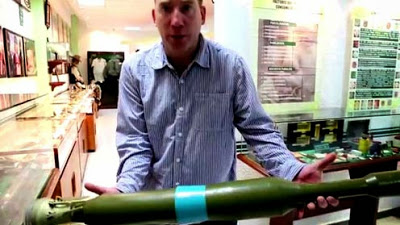 |
| Photo 1. PG-29 Round Held by Ioan Grillo |
Photo 2. Similar PG-29 Round in Hezbollah Cache
Photo 3. RPG-29 Launcher and Round
Key Information and
Analysis: RPG-29 Tandem Warhead Round
The unusual looking rocket
munition picked up for viewing by the narrator during the video documentary of
the Mexican Army’s private narco-war museum, the “Museo de Enervantes,” is a
PG-29VR Tandem-Warhead Round that is designed to be fired from the RPG-29
“Vampir”(Vampire) Portable Anti-tank Rocket Launcher [Photo 3].
This round is produced almost exclusively by
GNNP Bazalt in Russia, and previously, in the CIS (Common Wealth of Independent
States). Contradictory reports exist as
to the possible production of this round via SEDENA in Mexico, however, there
are questions concerning this.
Distribution via RFAS state factories, including export sales, is rather
limited in comparison to the standard HE (High Explosive) based PG (RPG based
rocket) rounds normally encountered.
Of great interest, regarding this
particular PG-29VR round, is a further inquiry that was made by the reporter
and author of the video, Ioan Grillo, to one of the Mexican officials at the
Museo de Enervantes. Mr. Grillo inquired
as to exactly where this round was encountered.
The Mexican official indicated to Mr. Grillo that the rocket he was
describing was not real, but simply a mock-up that they (the Mexican officials)
had produced. According to the official,
they wanted to show an example of the type of military weaponry that the
cartels were acquiring.














